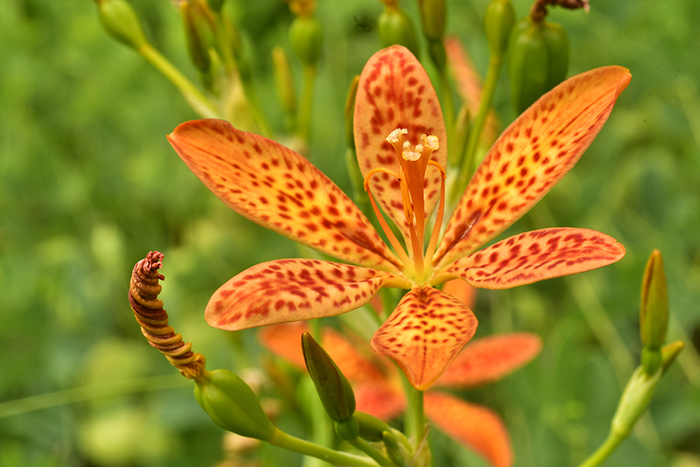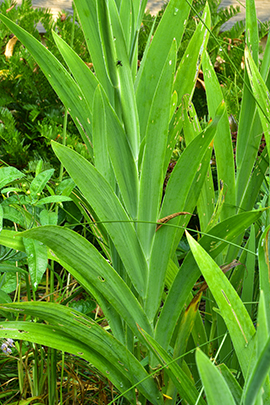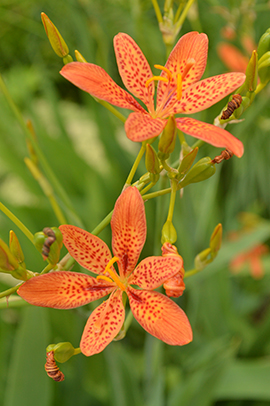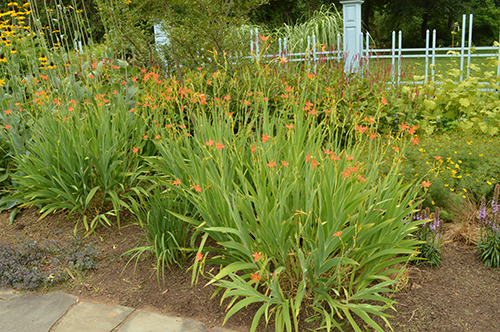
One botanical issue I have recently begun to struggle over is the seemingly endless number of plants undergoing a name change. The changes are certainly understandable since science now allows botanists to evaluate genomes and better align plants with the proper family or genera. Yet, learning new plant names is always a challenge and leads to confusion for both nurseries and gardeners. One plant that has proven to be particularly troublesome is Iris domestica, commonly called Blackberry Lily. With roughly 24 different botanical names since it was first described, I suspect it has frustrated more than a few gardeners over the years!
Regardless of the name, Iris domestica (as seen in Picture 1) has always been a member of the Iridaceae or Iris Family, so it is comforting to know that its familial ties over the centuries have remained intact! Of course, the common name further adds to the confusion, since it is not a member of the Lily Family! The plant is primarily native to China, although it may also be native to Eastern Russia and the Himalayas. Its age-old use as a medicinal promoted widespread trade between regions bordering China, making it difficult to pinpoint its original native provenance. When China opened its ports to European trade after 1689, Jesuit Missionaries and the East India Company began to ship seed from China and India back to England. At some point prior to the early 1700's Blackberry Lily seed reached England and ultimately Europe and beyond. It was originally named Ixia chinensis in 1753 by the Swedish botanist Carl Linnaeus (1707–1778). Ixia is from the Greek Ixos meaning 'Bird Lime', a reference to the sticky sap found within this genus of plants as well as Blackberry Lily. The majority of the roughly 50 species currently found within the genus Ixos are native to South Africa.
It was not until 1805 that the Belgium painter and botanist, Pierre Joseph Redouté (1759–1840) reclassified the plant as Belamcanda chinensis in his book Les Liliacées. It should be noted that the Swiss botanist Augustin Pyramus de Candolle (1778–1841) is often given credit for authoring this name. Both botanists contributed to the book, but it was Redouté who was the lead author and by international decree, he is credited with being the author of the genus. However, he did not craft the genus name of Belamcanda and the story of its name requires an additional look into the medicinal names of this plant. The rhizome of Blackberry Lily served in treatments for liver and chest ailments, among other illnesses. In China, the plant was known as Pinyin and Shê Kan and as the plant spread into India, it became commonly known as Balamtandan. It was the French botanist Michel Adanson (1727–1806) who latinized this Indian name in 1763, crafting the genus Belamcanda that was later adopted by Redouté.
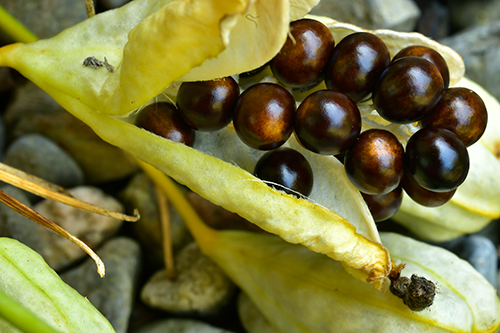
By the early 1800's the plant had made its way to North America where Thomas Jefferson started to grow it by 1807 at Monticello. He called it Chinese Ixia, so obviously Adanson's new name had yet to cross the Atlantic!
Interestingly, once accepted by most botanists, Redouté and Adanson's name remained steadfast until 2005, when the American botanist Peter Goldblatt (1943–) along with the British Botanist David Mabberley (1948–) reviewed the genetics of the plant and deduced it was more closely aligned with the genus Iris than botanists had previously thought. Consequently, they suggested moving the genus one more time to that of Iris. Since the species epithet of chinensis already described another Iris, the name of domestica was selected since the plant is domesticated and cultivated for medicinal use.
Blackberry Lily most strongly resembles a traditional 'Iris' during spring when the 18–24" tall fans of sword-like leaves radiate from the rhizomes. In late June or early July, a stout floral stem starts to elongate from the foliage, reaching upwards of 4 feet tall. The stem is adorned with 8–10" long leaves alternately arranged along the stem, as seen in Picture 2. The floral stem branches repeatedly near the top, producing numerous flat topped floral structures called cymes. Typical of cymes, the flowers near the center of the floral structure bloom first followed by those near the periphery. The 2" diameter flowers consist of 6 tepals in which the 3 outer sepals of the leafy calyx and 3 inner petals of the corolla look virtually identical. The tepals are typically an attractive orange, although yellow is not uncommon. Appearing throughout the tepals are dark, orange-red spots with blurred margins (as seen in Picture 3 and 7) that inspired another commonly used name of Leopard Lily. The blurred margins always make me wonder if my eyesight has suddenly worsened! Each flower blooms for close to one day, but there are ample buds to provide close to a month of bloom.
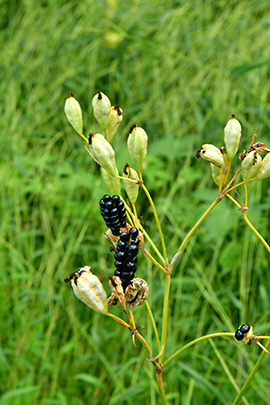
Appearing from the center of the flowers are 3 stamens and a tripartite stigma, whereby it is split into three distinct lobes at the tip. Unlike most Iris, the stamens do not form petal like structures and unlike true Lilies, it lacks the normal 6 stamens! The flowers attract numerous bee species along with Hummingbirds! As the flowers fade, they curiously twist in a counterclockwise rotation (as seen in Picture 7) revealing the swelling, oblong green seed pod beneath.
Come September, the outer covering of the seed pod splits open, revealing rows of black seeds that truly resemble ripe blackberries (as seen in Picture 4 and 5). The seeds are initially light brown as seen in Picture 4 and ripen to a dark purple to black. The seed pods remain attractive throughout the fall and winter, and are also very effective in dried flower arrangements inside the home. Once the seeds pods get too dusty after a year or so indoors, scatter the seeds outside – you will be surprised to see the seed is still viable and will germinate! I have yet to see any birds or mammals dining on the seeds during the fall and winter months.
It should be noted that Blackberry Lily is listed on some invasive plant lists, but I have only seen it spread as far as the stem supporting seed pods can stretch after falling. Unwanted seedlings and plants are easily extracted and after watching the seedlings slowly spread in one garden for over 20 years, I was amazed to see the rather diverse variation in the flower color, with some plants even showing a darker maroon-red floral color (Picture 7). However, I should not be too surprised considering Linnaeus selected the name Iris from the Greek ἶρις, meaning rainbow in recognition of the rainbow of flower colors expressed in this group of plants.
Iris domestica is an extraordinarily easy plant to grow. Thriving in full sun or light shade, the plant will prosper best in well-drained soils, even with neglect. Often thought to be tender, it is perfectly hardy in zones 5–10. Occasionally, the flower stems will collapse following heavy winds if the soils are too rich or if excessively fertilized.
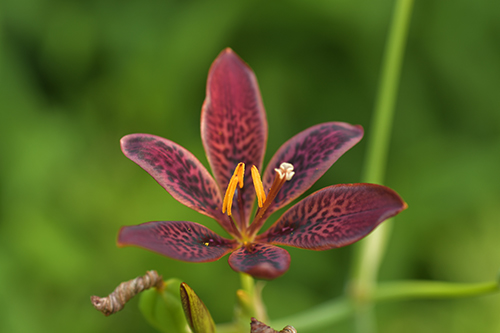
In China, they appear naturally in open grasslands and scrubby open woodlands, where the flowers appear as bright points of interest among the grasses. Perhaps a design consideration for NJ gardens! The orange flowers also look stunning when interplanted among blue flowered Nepeta (Catmint) or Perovskia (Russian Sage) species, as can be seen at Longwood Gardens by the Main Fountain Gardens or in the Rosary at Willowwood Arboretum!
Blackberry Lily is a fascinating plant with an equally fascinating medicinal and nomenclature history. No doubt it has frustrated more than a few gardeners over the years as the name changed. Hopefully, no further changes are in store for this plant, allowing more gardeners and nurseries to adapt to its classification under the genus Iris. Afterall, this 'Lily' is a great 'Iris' for the summer, fall and winter garden!
